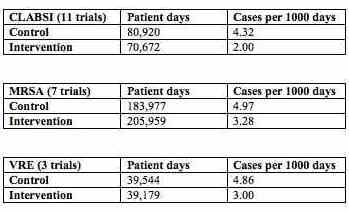A combination of strict antimicrobial stewardship and comprehensive infection control measures led to a 10-fold reduction in multi-drug resistant(MDR) A. Baumannii that had become endemic in a Korean intensive care unit (ICU). The initative is described in a recent paper in the Korean Journal of Internal Medicine.
Shinhye Cheon, Division of Infectious Diseases, Department of Internal Medicine, Chungnam National University School of Medicine, Daejeon, and colleagues, investigated the effectiveness of antimicrobial stewardship and intensified infection control measures for controlling endemic MDR A. baumannii in the 3 medical and surgical ICUs in Chungnam University Hospital in Korea (Cheon et al. 2016). Each ICU is a multi-bed open ward with one isolation bed.
Prior to the intervention, standard procedures included using gowns and gloves when dealing with infected patients, no restrictions on using antibiotics and cleaning using 0.01% sodium hypochlorite once a day.
See Also: Infection Prevention in the ICU
The infection control strategy comprised antimicrobial stewardship, hospital staff education that focused on when and how to perform hand hygiene, active surveillance cultures, contact precautions, environmental cleaning (increased from once to three times a day) and disinfection enforcement, including an additional worker assigned to perform an extra 2 hours of cleaning per day, as well as hand hygiene promotion. Carbapenems could be prescribed and renewed only with the approval of an infectious disease physician. Isolation using plastic curtains and contact precautions was applied to patients who were colonised or infected with MDR A. baumannii.
The outcome was measured as the incidence density rate of hospital-onset MDR A. baumannii among patients in the ICUs. Prior to the intervention the isolation rates of MDR A. baumannii had increased from 55.4% during January 2012 to 94.1% during March 2013, when the consumption of carbapenems was doubled.
Results
The incidence density rate of hospital-onset MDR A. baumannii decreased from 22.82 cases per 1,000 patient-days to 2.68 cases per 1,000 patient-days after implementation of the intervention. The mean monthly use of carbapenems decreased from 134.99 ± 82.26 defined daily doses per 1,000 patient-days to 94.85 ± 50.98 defined daily doses per 1,000 patient-days. Use of piperacillin/tazobactam and ciprofloxacin increased as these antibiotics were prescribed as alternatives to carbapenems. The study also found no statistical difference in all-cause mortality rates, MDR A. baumannii-related deaths and average length of ICU stays before and after the implementation of strict antimicrobial stewardship.
Chlorhexidine Gluconate Bathing
A meta-analysis published in the Journal of Critical Care found that chlorhexidine gluconate bathing reduces healthcare-associated infections in intensive care units, including central line–associated bloodstream infection (CLABSI), methicillin-resistant Staphylococcus aureus (MRSA), and vancomycin-resistant Enterococcus (VRE) (Kim et al. 2016). In addition a prolonged intervention period and concomitant nasal antibiotic use were associated with lower risks of MRSA acquisition.

The authors state that although the included studies had multiple heterogeneities in their
intervention and surveillance methods, these were only associated with a low to medium risk of bias.
Image credit: freeimages.com
Shinhye Cheon, Division of Infectious Diseases, Department of Internal Medicine, Chungnam National University School of Medicine, Daejeon, and colleagues, investigated the effectiveness of antimicrobial stewardship and intensified infection control measures for controlling endemic MDR A. baumannii in the 3 medical and surgical ICUs in Chungnam University Hospital in Korea (Cheon et al. 2016). Each ICU is a multi-bed open ward with one isolation bed.
Prior to the intervention, standard procedures included using gowns and gloves when dealing with infected patients, no restrictions on using antibiotics and cleaning using 0.01% sodium hypochlorite once a day.
See Also: Infection Prevention in the ICU
The infection control strategy comprised antimicrobial stewardship, hospital staff education that focused on when and how to perform hand hygiene, active surveillance cultures, contact precautions, environmental cleaning (increased from once to three times a day) and disinfection enforcement, including an additional worker assigned to perform an extra 2 hours of cleaning per day, as well as hand hygiene promotion. Carbapenems could be prescribed and renewed only with the approval of an infectious disease physician. Isolation using plastic curtains and contact precautions was applied to patients who were colonised or infected with MDR A. baumannii.
The outcome was measured as the incidence density rate of hospital-onset MDR A. baumannii among patients in the ICUs. Prior to the intervention the isolation rates of MDR A. baumannii had increased from 55.4% during January 2012 to 94.1% during March 2013, when the consumption of carbapenems was doubled.
Results
The incidence density rate of hospital-onset MDR A. baumannii decreased from 22.82 cases per 1,000 patient-days to 2.68 cases per 1,000 patient-days after implementation of the intervention. The mean monthly use of carbapenems decreased from 134.99 ± 82.26 defined daily doses per 1,000 patient-days to 94.85 ± 50.98 defined daily doses per 1,000 patient-days. Use of piperacillin/tazobactam and ciprofloxacin increased as these antibiotics were prescribed as alternatives to carbapenems. The study also found no statistical difference in all-cause mortality rates, MDR A. baumannii-related deaths and average length of ICU stays before and after the implementation of strict antimicrobial stewardship.
Chlorhexidine Gluconate Bathing
A meta-analysis published in the Journal of Critical Care found that chlorhexidine gluconate bathing reduces healthcare-associated infections in intensive care units, including central line–associated bloodstream infection (CLABSI), methicillin-resistant Staphylococcus aureus (MRSA), and vancomycin-resistant Enterococcus (VRE) (Kim et al. 2016). In addition a prolonged intervention period and concomitant nasal antibiotic use were associated with lower risks of MRSA acquisition.

The authors state that although the included studies had multiple heterogeneities in their
intervention and surveillance methods, these were only associated with a low to medium risk of bias.
Image credit: freeimages.com
References:
Cheon S, Kim MJ, Yun SJ et al. (2016) Controlling endemic multidrug-resistant Acinetobacter baumannii in Intensive Care Units using antimicrobial stewardship and infection control. Korean J Intern
Med, 31(2): 367-74.
Kim HY, Lee WK, Na S et al. (2016) The effects of chlorhexidine gluconate bathing on health care-associated infection in intensive care units: A meta-analysis. J Crit Care, 32:126-37. doi: 10.1016/j.jcrc.2015.11.011. Epub 2015 Dec 2.
Kim HY, Lee WK, Na S et al. (2016) The effects of chlorhexidine gluconate bathing on health care-associated infection in intensive care units: A meta-analysis. J Crit Care, 32:126-37. doi: 10.1016/j.jcrc.2015.11.011. Epub 2015 Dec 2.
Latest Articles
infection control, antimicrobial stewardship, chlorhexidine gluconate
A combination of strict antimicrobial stewardship and comprehensive infection control measures led to a 10-fold reduction in multi-drug resistant A. Baumannii that had become endemic in a Korean intensive care unit (ICU).



























